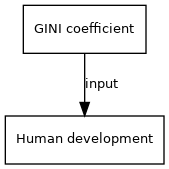GINI coefficient: Difference between revisions
Jump to navigation
Jump to search

m (Text replace - "|IsImpactIndicator=No" to "") |
No edit summary |
||
| Line 3: | Line 3: | ||
|Description=The GINI coefficient is a measure of income disparity in a population. If all enjoy the same income, GINI equals unity. The lower the GINI is, the wider is the gap between the lowest and highest income groups. | |Description=The GINI coefficient is a measure of income disparity in a population. If all enjoy the same income, GINI equals unity. The lower the GINI is, the wider is the gap between the lowest and highest income groups. | ||
|VariableType=driver | |VariableType=driver | ||
|Source2= | |Source2= | ||
|BasedOn2= | |BasedOn2= | ||
|Reference2= | |Reference2= | ||
|DriverGroup=Economic development | |DriverGroup=Economic development | ||
|Source=World Bank database; | |Source=Historic: World Bank database; future: Scenario assumption | ||
|Source3= | |||
|Reference2= | |||
|ExternalModel= | |ExternalModel= | ||
}} | }} | ||
Revision as of 14:53, 25 April 2014
| Label: | GINI coefficient |
| Description: | The GINI coefficient is a measure of income disparity in a population. If all enjoy the same income, GINI equals unity. The lower the GINI is, the wider is the gap between the lowest and highest income groups. |
| Variable type: | driver |
| Driver group: | Economic development |
| Source: | Historic: World Bank database; future: Scenario assumption |
Drivers are described in the Drivers component.
Variable is input of model component(s):

- Click on a box to open the model component.